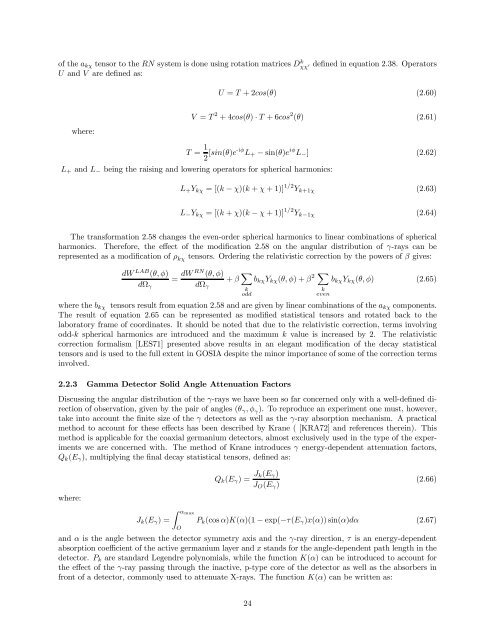coulomb excitation data analysis codes; gosia 2007 - Physics and ...
coulomb excitation data analysis codes; gosia 2007 - Physics and ...
coulomb excitation data analysis codes; gosia 2007 - Physics and ...
Create successful ePaper yourself
Turn your PDF publications into a flip-book with our unique Google optimized e-Paper software.
of the a kχ tensor to the RN system is done using rotation matrices Dχχ k definedinequation2.38. Operators0U <strong>and</strong> V are defined as:U = T +2cos(θ) (2.60)where:V = T 2 +4cos(θ) · T +6cos 2 (θ) (2.61)T = 1 2 [sin(θ)e-iφ L + − sin(θ)e iφ L − ] (2.62)L + <strong>and</strong> L − being the raising <strong>and</strong> lowering operators for spherical harmonics:L + Y kχ =[(k − χ)(k + χ +1)] 1/2 Y k+1χ (2.63)L − Y kχ =[(k + χ)(k − χ +1)] 1/2 Y k−1χ (2.64)The transformation 2.58 changes the even-order spherical harmonics to linear combinations of sphericalharmonics. Therefore, the effect of the modification 2.58 on the angular distribution of γ-rays can berepresented as a modification of ρ kχ tensors. Ordering the relativistic correction by the powers of β gives:dW LAB (θ, φ)= dW RN (θ, φ)+ β X b kχ Y kχ (θ, φ)+β X 2 b kχ Y kχ (θ, φ) (2.65)dΩ γ dΩ γkkodd evenwhere the b kχ tensors result from equation 2.58 <strong>and</strong> are given by linear combinations of the a kχ components.The result of equation 2.65 can be represented as modified statistical tensors <strong>and</strong> rotated back to thelaboratory frame of coordinates. It should be noted that due to the relativistic correction, terms involvingodd-k spherical harmonics are introduced <strong>and</strong> the maximum k value is increased by 2. The relativisticcorrection formalism [LES71] presented above results in an elegant modification of the decay statisticaltensors <strong>and</strong> is used to the full extent in GOSIA despite the minor importance of some of the correction termsinvolved.2.2.3 Gamma Detector Solid Angle Attenuation FactorsDiscussing the angular distribution of the γ-rays we have been so far concerned only with a well-defined directionof observation, given by the pair of angles (θ γ ,φ γ ). To reproduce an experiment one must, however,take into account the finite size of the γ detectors as well as the γ-ray absorption mechanism. A practicalmethod to account for these effects has been described by Krane ( [KRA72] <strong>and</strong> references therein). Thismethod is applicable for the coaxial germanium detectors, almost exclusively used in the type of the experimentswe are concerned with. The method of Krane introduces γ energy-dependent attenuation factors,Q k (E γ ), multiplying the final decay statistical tensors, defined as:where:Q k (E γ )= J k(E γ )J O (E γ )(2.66)J k (E γ )=Z αmaxOP k (cos α)K(α)(1 − exp(−τ(E γ )x(α)) sin(α)dα (2.67)<strong>and</strong> α is the angle between the detector symmetry axis <strong>and</strong> the γ-ray direction, τ is an energy-dependentabsorption coefficient of the active germanium layer <strong>and</strong> x st<strong>and</strong>s for the angle-dependent path length in thedetector. P k are st<strong>and</strong>ard Legendre polynomials, while the function K(α) can be introduced to account forthe effect of the γ-ray passing through the inactive, p-type core of the detector as well as the absorbers infront of a detector, commonly used to attenuate X-rays. The function K(α) can be written as:24
















